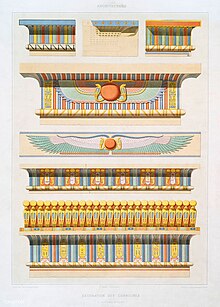Cornice
**Historical and Cultural Significance of Cornice:**
– Found in various ancient civilizations like Egyptian, Iranian, Etruscan, and Roman architecture
– Monumentalization in Etruscan and Roman architecture
– Reflects historical and artistic influences
– Demonstrates craftsmanship and surveying skills
– Seen in various architectural styles globally
– Showcased in sculptures and monuments
**Architectural Elements and Types of Cornices:**
– Part of columns and entablature in Classical architecture
– Modern residential buildings feature box, close, and open cornices
– Types include box, close, and open cornices
– Cavetto cornices influenced neighboring regions and early Greek architecture
– Obscure cornice varieties include architrave, bracketed, and modillion cornices
**Cornice Returns and Window Treatments:**
– Cornice return adds architectural detail to gable roofs
– Types of cornice return include Greek return and soffit return
– Window cornices are hard treatments along the top edge of a window
– Soft cornices are padded and covered in cloth
– Used to conceal mechanisms for opening and closing drapes
**Literature and Publication References on Cornice:**
– Detailed in books on residential construction and wood-frame house construction
– Referenced in daily life depictions of ancient Egyptians
– Mentioned in Grove Art Online for Iranian ancient architecture
– Described in books on American and European architecture
– Various publications by authors like Anderson, Thallon, Winter, Harris, and Spence
**Construction Details and Architectural Descriptions:**
– Detailed in historical texts, art publications, and construction guides
– Illustrated in American architecture encyclopedias
– Described in carpentry and building construction guides
– Authority control databases list variations in different countries
– Construction details published by Griffith and Farren in London
In architecture, a cornice (from the Italian cornice meaning "ledge") is generally any horizontal decorative moulding that crowns a building or furniture element—for example, the cornice over a door or window, around the top edge of a pedestal, or along the top of an interior wall. A simple cornice may be formed just with a crown, as in crown moulding atop an interior wall or above kitchen cabinets or a bookcase.


A projecting cornice on a building has the function of throwing rainwater free of its walls. In residential building practice, this function is handled by projecting gable ends, roof eaves and gutters. However, house eaves may also be called "cornices" if they are finished with decorative moulding. In this sense, while most cornices are also eaves (overhanging the sides of the building), not all eaves are usually considered cornices. Eaves are primarily functional and not necessarily decorative, while cornices have a decorative aspect.
A building's projecting cornice may appear to be heavy and hence in danger of falling, particularly on commercial buildings, but often may actually be very light, made of pressed metal.
